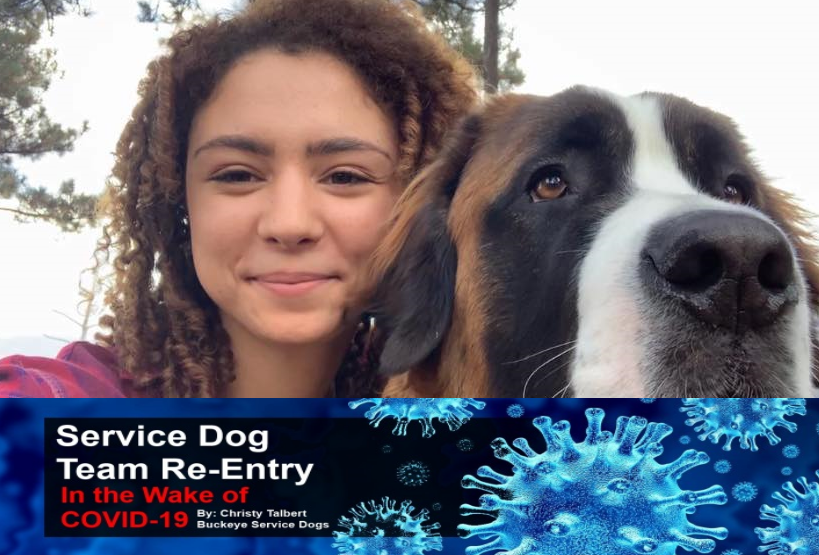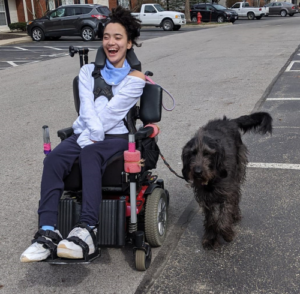
After 40 years as a service dog trainer, not much surprises me. Not dog behavior, not client challenges. This isn’t my first rodeo. I’ve been through it all, or so I thought. Then, a worldwide pandemic hit. My training and work with clients has been disrupted. More urgently, so have the routines and teamwork of tens of thousands of service dog partnerships across the country and world. Although we humans are starting to cautiously peek out of our doorways again, service dogs and their handlers face some unique challenges in the coming weeks and months.
Consider the story I recently received from veteran service dog handler KB:
I only needed a couple things at the store and I was almost done. I picked my last item, a bottle of Benadryl, and promptly dropped it. I was tired and dizzy enough that I was not bending over to pick up this bottle. Besides, that’s why I have a service dog.
Take it. Ludo looked at me and sat. No, I nudged his butt with my foot.
Take it. I pointed at the bottle, and he seemed to get the picture. He bowed down and started batting the bottle around with his feet. Basically, acting like the idiot I know and love, but didn’t need in that particular moment. I corrected the behavior.
Take it. I tried again, still nothing. He looked a little confused. I could see the guy at the end of the aisle subtly side-eyeing us. With a melodramatic sigh, I sat down on the ground. (Like I said, bending over wasn’t happening.)
I picked up the bottle, held it about an inch from the ground and tried again. Take it. He did! I praised him and started the process of standing back up. The guy down the aisle was looking. I caught his eye and smiled. “He hasn’t been out working in a while.” His response led me to think this was one of those conversations that was just meant to happen: “Hey, I mean, I think we’ll all be a little rusty when we get back to work!”
Then it hit me. I was like a math teacher. I was like that overbearing math teacher I had the senior year of high school. The one who expected me to remember everything I learned the year before, despite me spending the summer swimming, vacationing, and doing almost zero math. But, I hadn’t been thinking of it like that. I’d been taking Ludo out – harnessed – to public parks to keep up his behavior and practicing task work at home. I mistakenly thought that this would be enough, and. I was wrong. I’d spent the last couple months practicing algebra with him, and now I was expecting Ludo to do calculus.
I think this is the problem a lot of handlers will face as we head back to normal(ish) life. How do we maintain service dog standards without expecting too much from our dogs or ourselves?
KB’s experience is going to be a common one this summer. So, as our country begins a slow reopening, I want to spend a few minutes on two questions I’ve been considering deeply. What challenges face service dog teams as they venture out once again? And, what strategies might help in negotiating this new reality they face?
The Lockdown’s Effects
In order to consider how to move forward, I want to start with the various ways that staying at home have likely impacted you, your service dog partner, and your teamwork.
We humans understand what has been happening. We know why we have been staying at home. We get why our routine has been disrupted and we know that at some point, those disruptions and restrictions will become less confining. Life will return to some kind of normal – even if it’s a new normal.
Now, let’s consider the typical service dog. One morning he wakes up, expecting to go to work, or college, or run errands just like any other day. Instead, he stays home. Not so bad. His handler/friend gives him additional attention and everything seems okay. But, day after day, they stay home, again. Ten days, twenty, sixty.
On top of that, their handler seems to be acting a little off. A bit nervous and distracted. Somewhat withdrawn. Maybe fearful. The dog notices these things, but of course doesn’t know why. Soon a month goes by, then two. The new routine, as far as the dog is concerned, is that she stays home, with her handler, 24/7. Her handler is always in sight. She probably is never caged because there is no point. Nobody is going anywhere, anyway.
The dog’s house manners have likely slipped a bit. He has stolen some food off of the counter. He barges out the door when it’s time for a walk, because he is so excited to GO. When a stranger enters (which rarely happens), they are wearing a scary mask and the dog feels the need to protect his shrunken world with a skeptical “grrrr.”
I’m also going to presuppose that you are feeling some anxiety at going out again. Maybe you are concerned due to your fragile health. Maybe whatever emotional challenges you face have been magnified by COVID-19. Perhaps you have gotten used to cocooning, and are dreading the pressures of your pre-pandemic routine – a routine which will likely be more difficult to negotiate due to various social distancing and business protocols. On top of it all, you have a sneaking (and probably accurate) suspicion that your dog in May 2020 is not behaving like it was three months ago.
Some Encouragement

First and foremost, let me assure you, your dog is not broken. Your partnership is not over. You will both make it through this.
How do I know your dog is not broken? Your canine partner has been through many major routine shifts over the course of his/her life. Among them: removal from birth litter; placement in a pet or foster home; placement with a trainer or at a training facility; and then ultimately becoming your partner. Each of these life disruptions involved your dog learning new routines, rules, and behaviors. And, in each case your dog negotiated these successfully – your partnership is evidence of that. For your dog this current situation is just one more transition. And, your dog is an expert at transitions!
Also, let me reassure you – your dog’s training is “still in there.” He may have pilfered a chicken breast off your counter. She may be slow on her sits and downs, or she may be tugging at the leash a little bit. He may even be rusty on some of his task work. However, all the training and conditioning that created a great service dog is still there. Getting your dog’s behavior back to optimum will take a little work, but you will NOT be starting over. Think of it like riding a bike. Your dog has not ridden its bike for a few months, but HE STILL KNOWS HOW. A little practice and you two will be doing wheelies again.
Your handling and training skills are still there as well. What has slipped, perhaps, are your expectations. This secluded world you have been living in has not required your dog to maintain excellent behavior, so that has not been your first priority. Your priority has been toilet paper and hand sanitizer, and that’s fine. However, you have spent the history of your partnership being the leader of your team. Now, it’s time to step up and take on that role again. When you do, I think you will be surprised at how quickly your dog salutes you with a snappy response to your commands and adopts a willing, humble, and respectful attitude.
General Plan For Re-Entry
It’s always good to start with a baseline. Begin by honestly assessing:
- Your feelings about getting back to public life
- Your dog’s current behavior in his/her current environment and routines
- Whatever fears or anxieties you have regarding your dog going back into public with you
Remember, this is your starting point. It is what it is. No use beating yourself up over it or getting upset with your dog. Instead, begin taking positive steps.
You will begin your partnership reset at home. Why? It’s much easier to re-establish your leadership at home than it is in the grocery store, where you may be feeling anxious and worried.
Make a list of your dog’s poor behavior at home and on walks. Make no excuses for the issues. Is he screaming in his crate? Does he tantrum when he can’t see you? Is she a food thief? Has she developed possessiveness around a toy or food, or is she skeptical of folks who enter your home? Has her behavior toward other dogs/people/or animals on walks become difficult to manage?
If so, begin today to enforce the old rules on home territory. Leave a training collar and short leash on your dog at all times in your home so you can correct it when needed. Spend ten minutes, three times a day working on obedience, and be strict. Make your dog do it right – make it perform like it did when you became a team.
Fix what you can at home, and do so rapidly. Don’t ease into discipline slowly. Have a bit of a boot camp mentality. Make your expectations clear and do not get bogged down in “why” your dog is acting this way. Say “NO” and mean it. Follow up with an effective leash correction with a training collar. Expect that you will be correcting your dog a lot for 48 hours or so. Also expect a dramatic positive shift in your dog’s home behavior. He may look a little chagrined and a little humbled. That’s actually good. Your dog will quickly remember the rules and soon enough will be happy for your return to loving leadership.
Next, begin making small outings to places you have not frequented since being sequestered. Go with the express goal to TRAIN, rather than going with the intention of shopping or doing some other errand. Begin by brief visits to “easy” places such as a drug store, or sparsely populated retail area. If you are feeling anxious, break things up into chunks you can emotionally manage. That may mean entering a drugstore, and going right back out the exit. Or, it may mean walking to the back of the store, then back to the front and out. However long you spend, keep your focus on your dog. Make them walk properly on a loose lead. Tell them to sit stay or down stay. Have them back up a few steps in an aisle. Have them do SOMETHING to remind you both that you are the leader.
Try to get out at least five times per week. As you and your dog become more used to going out again, step up the level of the outing. Go grocery shopping. Go to the mall. Your progress may seem incremental, but as long as you are pushing the envelope of your comfort just a bit and challenging your dog to act appropriately, your baby steps will be rewarded with a big payout!
More Helpful Hints
- Do keep in mind that your dog is rusty. Expect good behavior but also be realistic. Consider KB’s story. If you need to “back up” to an easier version of the task or obedience exercise, then back up to the point where you are successful and work from there.
- Remember to praise your dog a bunch for their progress – even if you just corrected them. You will be stepping your expectations and corrections so you must make a corresponding increase in the exuberance of your praise.
- Do acclimate your dog to masks or any other unique environmental or social challenges that come up. Take the time to stop and train these new challenges, don’t just expect your dog to understand.
- Do ask for help from your dog’s trainer/organization if you are struggling, but don’t expect them to fix your dog. Follow their input and realize you are able to do this!
- Do not beat yourself up if you are more anxious than is normal for you. We all are. Baby steps.
- Do not look for excuses for your dog’s poor behavior. The “why” does not matter. Just fix it.
- Do not expect it to take as long to fix the behavior as it took for it to decline. The decline was a slow tire leak. You are going to patch the hole and re-inflate the tire, and it will not take three months.
- Do consider pairing up with another SD team and working through challenges together. You can cheer one another on, and your dogs will take confidence from having a canine friend along.
- Do share this article in forums to help other teams.
Thanks for reading and sharing this article. If it was helpful, I’d love to know. Please feel free to email me!
About the author: Christy Talbert has been training mobility, medical alert, and psychiatric service dogs for more than 40 years. She is the owner of Buckeye Service Dogs, located near Columbus, Ohio. She can be reached at BuckeyeServiceDogs@gmail.com
